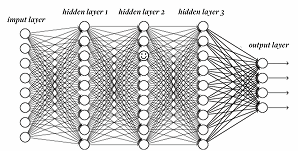 Interesting piece here reviewing the way some modern machine learning systems are unfathomable. This is because they learn how to do what they do, rather than being set up with a program, so there is no reassuring algorithm – no set of instructions that tells us how they work. In fact they way they make their decisions may be impossible to grasp properly even if we know all the details because it just exceeds in brute complexity what we can ever get our minds around.
Interesting piece here reviewing the way some modern machine learning systems are unfathomable. This is because they learn how to do what they do, rather than being set up with a program, so there is no reassuring algorithm – no set of instructions that tells us how they work. In fact they way they make their decisions may be impossible to grasp properly even if we know all the details because it just exceeds in brute complexity what we can ever get our minds around.
This is not really new. Neural nets that learn for themselves have always been a bit inscrutable. One problem with this is brittleness: when the system fails it may not fail in ways that are safe and manageable, but disastrously. This old problem is becoming more important mainly because new approaches to deep machine learning are doing so well; all of a sudden we seem to be getting a rush of new systems that really work effectively at quite complex real world tasks. The problems are no longer academic.
Brittle behaviour may come about when the system learns its task from a limited data set. It does not understand the data and is simply good at picking out correlations, so sometimes it may pick out features of the original data set that work well within that set, and perhaps even work well on quite a lot of new real world data, but don’t really capture what’s important. The program is meant to check whether a station platform is dangerously full of people, for example; in the set of pictures provided it finds that all it needs to do is examine the white platform area and check how dark it is. The more people there are, the darker it looks. This turns out to work quite well in real life, too. Then summer comes and people start wearing light coloured clothes…
There are ways to cope with this. We could build in various safeguards. We could make sure we use big and realistic datasets for training or perhaps allow learning to continue in real world contexts. Or we could just decide never to use a system that doesn’t have an algorithm we can examine; but there would be a price to pay in terms of efficiency for that; it might even be that we would have to give up on certain things that can only be effectively automated with relatively sophisticated deep learning methods. We’re told that the EU contemplates a law embodying a right to explanations of how software works. To philosophers I think this must sound like a marvellous new gravy train, as there will obviously be a need to adjudicate what counts as an adequate explanation, a notoriously problematic issue. (I am available as a witness in any litigation for reasonable hourly fees.)
The article points out that the incomprehensibility of neural network-based systems is in some ways really quite like the incomprehensibility of the good old human brain. Why wouldn’t it be? After all, neural nets were based on the brain. Now it’s true that even in the beginning they were very rough approximations of real neurology and in practical modern systems the neural qualities of neural nets are little more than a polite fiction. Still, perhaps there are properties shared by all learning systems?
One reason deep learning may run into problems is the difficulty AI always has in dealing with relevance. The ability to spot relevance no doubt helps the human brain check whether it is learning about the right kind of thing, but it has always been difficult to work out quite how our brains do it, and this might mean an essential element is missing from AI approaches.
It is tempting, though, to think that this is in part another manifestation of the fact that AI systems get trained on limited data sets. Maybe the radical answer is to stop feeding them tailored data sets and let our robots live in the real world; in other words, if we want reliable deep learning perhaps our robots have to roam free and replicate the wider human experience of the world at large? To date the project of creating human-style cognition has been in some sense motivated by mere curiosity (and yes, by the feeling that it would be pretty cool to have a robot pal) ; are we seeing here the outline of an argument that human-style AGI might actually be the answer to genuine engineering problems?
What about those explanations? Instead of retaining philosophers and lawyers to argue the case, could we think about building in a new module to our systems, one that keeps overall track of the AI and can report the broad currents of activity within it? It wouldn’t be perfect but it might give us broad clues as to why the system was making the decisions it was, and even allow us to delicately feed in some guidance. Doesn’t such a module start to sound like, well, consciousness? Could it be that we are beginning to see the outline of the rationales behind some of God’s design choices?
